While
Curry can be made from start to finish in 30 minutes, and is why I tend to make it several times a week,
Biriyani is the ultimate slow food. I tend to make it on lazy Sunday afternoons when I am just puttering around the house. It is a multi step cooking process that takes about three hours to prepare if you want real home style
Biriyani. The long cooking process is well worth the effort, as
Biriyani dishes have a complexity flavors that is impossible to achieve with quickly cooked foods.
The star ingredient of this Chicken Biriyani dish is
Pickled Lemon relish. I first tasted this at
Hot Stuff, a great little Indian restaurant in London. When I got back home I searched it out at local Indian grocery stores until I found one that tasted just like the relish I had in London, and this
Lemon Pickle made by
Nirav is delicious. Just the right combination of sweet, sour, and heat...

I marinate boneless chicken thighs in some
olive oil,
Madras Curry powder,
Garlic Chili sauce, and
Lemon Pickle. Mix together well and let it marinate for at least a hour...

Now saute some onions and peppers in some oil...
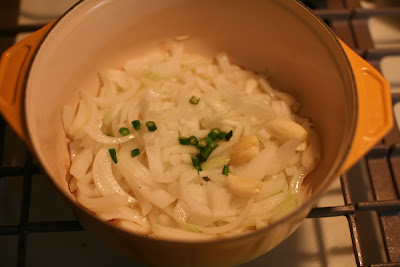
add a couple tablespoons of finely chopped Lemon Pickle...

when the onions have cooked down add some diced Yellow Squash...

add some
Basil,
Black pepper, and some grated
Nutmeg and let simmer for several minutes...
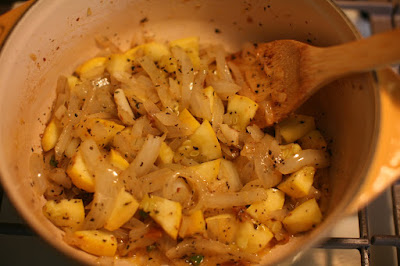
Now grill the Chicken thighs...

Takes no more than ten minutes. They should be pink inside...

Dice the chicken and add it to the vegetables, and mix together...
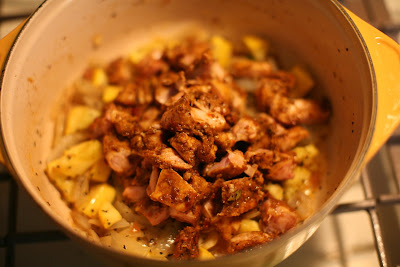
Remove all of these ingredients to a bowl, and then rinse out your pan and then return it to the stove and melt some butter or Ghee in the bottom...

Before I started any of the other cooking, I steamed three cups of
brown rice in my rice cooker with some
bay leaves and
star anise added to the cooking water...

Place half of the rice in the bottom of the pot. I am using a heavy enameled cast iron dutch oven...

Now put the chicken and vegetable mixture over the layer of rice...

Then cover that with the remaining rice, and you can put the bay leaves and star anise from the rice cooking on top...

Now are several important steps. The
Biriyani will be roasted
Dum style. This is a very slow cooking method in as tight a roasting pot as possible. Almost a form of pressure cooking. The best way to do this is to cover the pot with a layer of aluminum foil, then cover with the pot lid and scrunch up the foil around the edge as a seal. Indian cooks use dough to seal the lid. The
Biriyani also needs to be cooked at a very low heat. I set the burner to it's lowest flame setting and then raise the pot off of the stove top using my wok burner grill. This raises the pot off of the flame about 1 1/2 inches. You could also roast the Biriyani in a very low oven. I leave it on the burner to roast
Dum style for at least an hour...

During that long slow roast, the Biriyani develops a complex and intense level of flavors. The smoke and spice from the chicken play off of the citrus of the Lemon Pickle so well. This is just incredible tasting, and is even better the next day!

























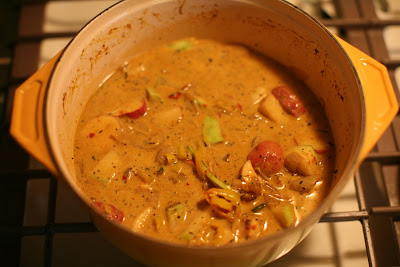

 thai dragon peppers
thai dragon peppers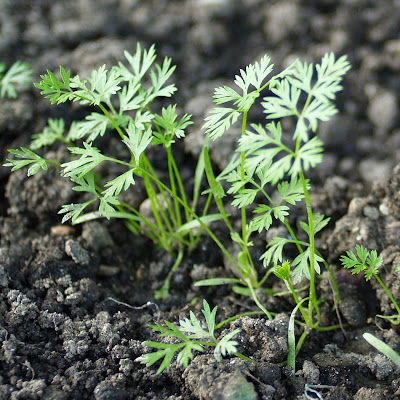 carrots
carrots container pumpkins
container pumpkins genovese basil
genovese basil tom thumb tomatoes
tom thumb tomatoes amish heirloom bed
amish heirloom bed










 beets. june 6, 2009
beets. june 6, 2009 carrots. june 6, 2009
carrots. june 6, 2009 turnips. june 6, 2009
turnips. june 6, 2009 micro greens
micro greens

